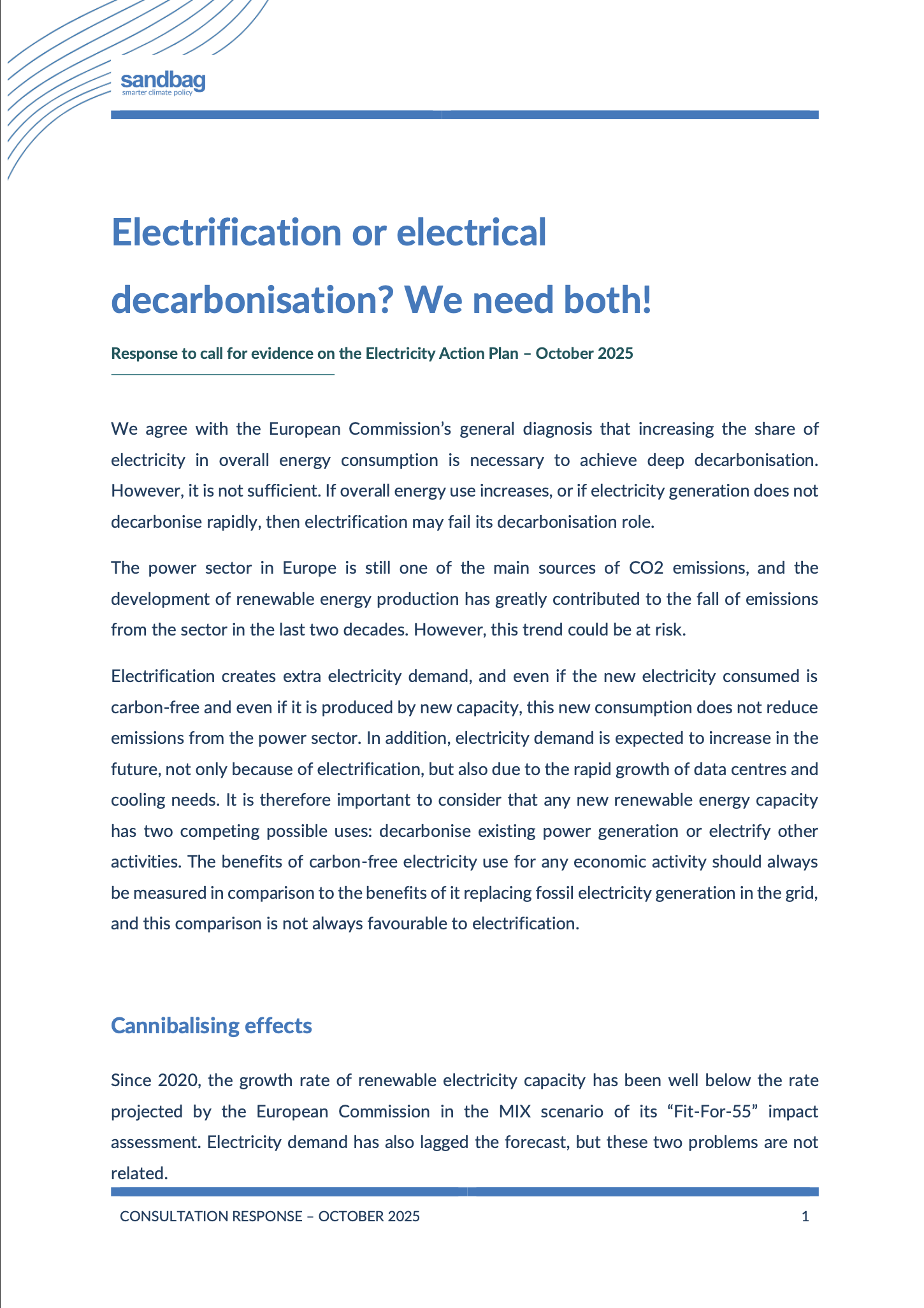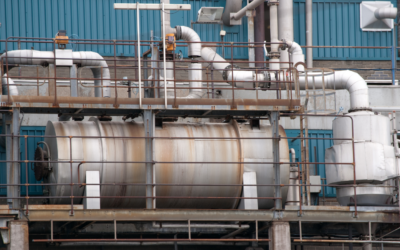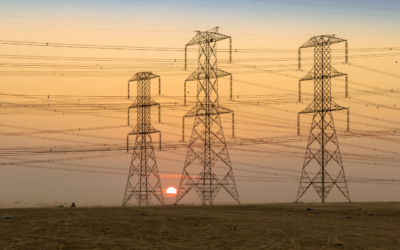This document is Sandbag’s response to the European Commission’s call for evidence on the forthcoming Electricity Action Plan.
It outlines why electrification alone is not sufficient for decarbonisation — and stresses the urgent need to accelerate the decarbonisation of electricity generation itself.

We agree with the European Commission’s general diagnosis that increasing the share of electricity in overall energy consumption is necessary to achieve deep decarbonisation. However, it is not sufficient. If overall energy use increases, or if electricity generation does not decarbonise rapidly, then electrification may fail its decarbonisation role. The power sector in Europe is still one of the main sources of CO2 emissions, and the development of renewable energy production has greatly contributed to the fall of emissions from the sector in the last two decades. However, this trend could be at risk.
Electrification creates extra electricity demand, and even if the new electricity consumed is carbon-free and even if it is produced by new capacity, this new consumption does not reduce emissions from the power sector. In addition, electricity demand is expected to increase in the future, not only because of electrification, but also due to the rapid growth of data centres and cooling needs. It is therefore important to consider that any new renewable energy capacity has two competing possible uses: decarbonise existing power generation or electrify other activities. The benefits of carbon-free electricity use for any economic activity should always be measured in comparison to the benefits of it replacing fossil electricity generation in the grid, and this comparison is not always favourable to electrification.
Cannibalising effects
Since 2020, the growth rate of renewable electricity capacity has been well below the rate projected by the European Commission in the MIX scenario of its “Fit-For-55” impact assessment. Electricity demand has also lagged the forecast, but these two problems are not related. The slow development of renewables in Europe has many reasons and it would be a mistake to try to resolve it through increased demand only. Electrifying the economy is unlikely to drive, by itself, any significant acceleration of renewables build. In many EU regions, most of electricity demand is currently matched by coal and gas power generation and there is insufficient renewables capacity to chase the fossil out of the grid. As a result, electricity prices are generally high, and renewables are profitable yet still underdeveloped.
In those places, an increase in electricity demand is likely to cannibalise the decarbonisation of power generation, inducing CO2 emissions. The electrification of economic activities may reduce emissions in those other activities, but those reductions should be counted against the emissions induced by their slowing effect on the replacement of fossil power generation.
Careful subsidy design
An easy temptation to speed up electrification is to grant subsidies. However, when the supply has bottlenecks, subsidies only drive prices up instead of increasing the deployment of renewables. Higher electricity prices benefit fossil generation, which is likely to increase as a result, at the taxpayer’s expense. An example of bad subsidy design is the Innovation Fund’s criteria measuring the carbon footprint of projects selected to receive grants. According to the criteria, any electricity used by a project is considered as carbon-free (zero indirect emissions) because of the underlying assumption that the power sector will have decarbonised over the 10-year lifetime of the projects. However, this assumption is wrong if projects use grid power indiscriminately, and if electrification is not matched by new renewable power supply that significantly exceeds the power used for new projects. The criteria measuring the carbon footprint of projects applying for Innovation Fund grants should therefore be reformed to take into account induced emissions.
“The RFNBO standard should take into account induced emissions”.
Other subsidy schemes take care of not creating 24-hour “rigid demand”, but insufficiently to avoid induced emissions. An example of bad subsidy design is the Hydrogen Bank, which supports the deployment of RFNBO production. The RFNBO standard qualifies hydrogen- derived fuels coming from “additional” renewable sources, regardless of the emissions induced by the use of those sources for hydrogen rather than decarbonising the grid. Research from Sandbag showed that, in some countries, RFNBO production could be three times more emission-intensive than “grey” hydrogen production from steam methane reforming, even after the ambitious 2030 targets are met for renewable energy use. This standard should be reformed to take into account induced emissions and avoid costly cannibalisation of power decarbonisation.
Another example where caution should be applied is the auction for electrification of industrial heat through the Innovation Fund, currently being designed. Electrification of gas-fired heat only brings climate benefits if the electricity needed to replace it does lead to burning more gas. Given the 40% energy conversion efficiency of most gas plants, if a country grid requires gas generation 100% of the time, electrification will only benefit the climate if it has a coefficient of performance (COP) of over 2.5. If its COP is only 1, the electrification only makes sense if the equipment is used at times without fossil power demand for 60% of the time. In the subsidy design, this calculation should be taken into account, and projects selected accordingly.
Develop flexibility and interconnection
We agree with the Commission’s diagnosis that “a primary characteristic of cost-effective electrification is flexibility, which needs to be enabled by digitalisation and market-based incentives”, whereas “electrification of rigid demand may add to system costs and affect affordability”. As Sandbag showed in a report last year, flexibility in e.g. the aluminium sector is more difficult to achieve than for the housing sector. Yet, most households do not have access to flexible-price electricity supply and are therefore rigid demand loads.
Maximum incentives for flexibility should be offered to all sectors, particularly those with high flexibility. This can be achieved through pricing. Most power users consume power at fixed prices. The wholesale power market is dominated by so-called “take-or-pay”, “baseload” contracts which create no incentive for flexibility.
The power market should be reformed to better reflect spot prices and allow for intermittent demand. If the users with high flexibility adjusted their consumption to carbon-free supply patterns, those with lower flexibility would have more carbon-free electricity left and have to bear less flexibility efforts. Incentives for flexibility could go beyond the current price differential between high and low spot prices, as flexibility creates high operational costs for industrial users: oversizing production facilities to increase production at times of low prices, stocking up more products, delaying client orders, adjusting workforce etc. Subsidy schemes could, for example, reward industrial production at times when spot prices are lower than €20 per MWh (at which price we are certain that no fossil power generation is caused), regardless of the real price really paid by the user.
According to the background document to this consultation, “the EU electricity market is deeply interconnected”. However, large differences in power prices between regions still suggest that interconnection could be improved. Since running flexible equipment comes at a cost, the overall benefits brought by electrification projects in regions of abundant low-carbon power should therefore be carefully compared with alternatives such as improved grid interconnection, which also provide valuable emission savings thanks to the displacement of fossil electricity in countries connected to neighbours with high renewables production.
Related publications
Heat up industry, not the climate!
This position paper analyses the European Commission’s industrial heat auction, highlighting the importance of auction design to ensure electrification reduces emissions without causing unintended increases due to electricity grid dynamics.
Getting Electrification Right: The broader challenge of induced emissions
Sandbag’s latest report explores how the climate impact of electricity use depends not just on how it’s generated, but also when and where it’s consumed. Using hydrogen as a case study, the report shows how poorly timed renewable electricity use can unintentionally drive-up fossil fuel emissions — and outlines smarter paths to decarbonisation.
Auction for industrial heat electrification: A positive step, but mind the induced emissions!
This position paper analyses the European Commission’s industrial heat auction, highlighting the importance of auction design to ensure electrification reduces emissions without causing unintended increases due to electricity grid dynamics.


